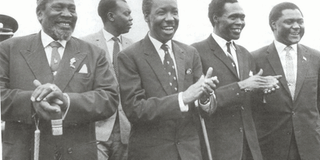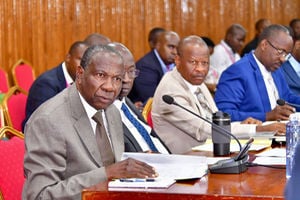Nyerere: Does he deserve to be made saint?

Nyerere during a state visit to Uganda in the 1980s. Below (L-R) is former Kenyan president Jomo Kenyatta, Nyerere and former Uganda president Milton Obote. Nyerere could be made saint if the Catholic Church finds him fit. courtesy photo
What you need to know:
Sainthood. Tanzania’s first president, a teacher cum politician, is held in high esteem among his countrymen. But will he become a saint? We look at his chances.
Kampala.
On June 1, 2009, Julius Kambarage Nyerere Day was declared during a Holy mass celebrated at Namugongo Catholic Shrine.
It was during the mass that the Rev Fr Deogratius Ssonko, the Rector of the Namugongo Parish, proposed that the Day was to pray for the cause of his process of beatification and canonisation. He was seconded by His Grace Dr Cyprian Lwanga archbishop of Kampala Archdiocese who led the holy mass.
President Museveni, former Tanzania President Benjamin Mkapa, and Mama Maria Nyerere, among other dignitaries, were also present. This was after a series of prayers and requests that started in 2006 and extended from Tanzania to the Catholic Church in Uganda.
This is contained in the booklet Julius Kambarage Nyerere: Let us pray for his beatification authored by Mama Maria Nyerere and Family in April, 2014. The booklet reveals how the Cause of beatification started. “After the 21st January 2006’s official inauguration of the Cause of the beatification of the Father of the Tanzania Nation, enlightened by the Holy Spirit, Mama Maria Nyerere and her family requested the Catholic Church in Uganda to celebrate Holy Mass for intercession for the Cause of the beatification and canonisation of Mwalimu Julius Kambarage Nyerere”, the booklet reads in part.
This was officially launched at Nyerere’s home parish of Butiama, Musoma Diocese. Later, the Catholic Church in Uganda granted her request. That is how the Nyerere Day was initiated.
This was also after the request to the Holy-See by Bishop Justin Samba of Musoma Diocese and the Tanzania Episcopal Conference TEC in 2005 to declare Nyerere a saint. On May 13, 2005, the Holy Father, Pope Benedict XVI, declared Julius Kambarage Nyerere the Servant of God which is also the first step for the start of the beatification and finally canonisation to sainthood.
Miracles
So is it true that for someone to be declared a Saint, they must have performed miracles; in accordance with the Catholic Church? Yes, Rev Father Joseph Mukasa, the Protector of Devotion for the Uganda Martyrs at Namugongo Basilica, says. “Someone has to begin the process to show that this person’s life had an ‘odour’ of sanctity before or after death.
And if it is found to be true, the Pope will declare this person Servant of God”. That is the first step. From there, the Pope declares officially, that believers can pray for or through that person for God to perform the miracle.
If a miracle happens, and after the church has verified it to be true, the Pope will declare that person to the state of the venerable.
And when the second miracle happens, that person will be beatified and later canonised which means putting one’s name on the official catalogue of Saints in the Catholic Church,” Fr Mukasa elaborates. Asked if there has ever been a politician declared a Saint in the Catholic Church, the clergy said: “To the best of my knowledge I don’t know any”.
Did Nyerere perform any miracles during his life or after death? Not one is recorded yet by the Catholic Church authorities, although they are claims yet to be officially investigated.
But according to the booklet: Julius Kambarage Nyererere: Let us pray for his beatification” which was also distributed during the last Martyrs Day at Namugongo, Nyerere throughout his life was a staunch Catholic faithful who attended the Holy Mass everyday and received the Holy communion while kneeling as a sign of respect to the Lord Christ, a fighter for peace and social justice, a loving father, respected elder and above all, he was an honest man.
Is that enough for Nyerere to be beatified and later canonised as a Saint? Rev Fr Mukasa says: “The gravity may vary from person to person”, but adds that: “The Church must always be careful”. As for Nyerere’s case, he says: “Let us keep the trust in the relevant church organs who are working hand in hand with the congregation for the Cause in Rome”.
Nyerere died of leukemia on October 14, 1999 in a hospital in London.
How one becomes a saint
According to the Canon Law 1187, of the Catholic Church, the process of Sainthood starts after the death of that individual. In other words, a living person cannot be a saint.
It involves the opening of the Cause of Beatification and ends with the Canonisation when the Pope declares them Servant of God later Venerable after Beatification and lastly Canonisation after which they are declared saints.
However, exemplary life that is adorable can also lead to the rewarding by miracles performed through that person.
If miracles happen through such people, the Bishop of the diocese where that person lived or died informs the Vatican and the process to document evidence starts. If the team of experts and the Congregation of Causes of Saints investigates and approves, the Pope issues a decree proclaiming them Saints.
case of John Paul II
John Paul II’s cause for canonisation commenced in 2005 one month after his death with the traditional five-year waiting period waived. On December 19, 2009, John Paul II was proclaimed Venerable by his successor Pope Benedict XVI and was beatified on 1 May 2011 after the Congregation for the Causes of Saints attributed one miracle to him, the healing of a French nun from Parkinson’s disease.
A second miracle, attributed to the late pope, was approved on July 2 2013 and confirmed by Pope Francis two days later. John Paul II was canonised on April 27, 2014, alongside Pope John XXIII. Like John XXIII, his feast day is not celebrated on the date of his death as is usual, but on the anniversary of his papal inauguration, October 22, 1978.




